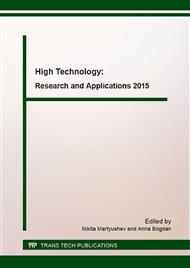[1]
E. Lee, Elastic-plastic deformation at finite strains, Trans ASME: J. Appl. Mech., 36(1) (1969) 1-6.
Google Scholar
[2]
V.I. Levitas, Large elastoplastic deformation of materials at high pressure. Kiev: Nauk. Dumka, 1987. 232 p. (In Russian).
Google Scholar
[3]
G.I. Bykovtsev, A.V. Shitikov, Finite deformation elastoplastic media, Reports of the Academy of Sciences of the USSR, 311(1) (1990) 59-62. (In Russian).
Google Scholar
[4]
A.A. Rogovoy, Defining relations for finite elastic-inelastic deformations, Journal of Applied Mechanics and Technical Physics, 46(5) (2005) 138-149.
Google Scholar
[5]
A.D. Chernyshov, Constitutive equations for elastic-plastic body at final deformations, Bulletin RAN, Mechanics of Solids, 1 (2000) 120-128.
Google Scholar
[6]
A.A. Pozdeev, P.V. Trusov, Y.I. Nyashina, Large elastoplastic deformation: theory, algorithms, applications. M.: Nauka. 1986. 232 p. (In Russian).
Google Scholar
[7]
A.A. Burenin, G.I. Bykovtsev, L.V. Kovtanyuk, On a simple model for elastoplastic medium at finite deformations, Reports of the Russian Academy of Sciences, 347(2) (1996) 199-201.
Google Scholar
[8]
V.P. Myasnikov, The equations of motion of elastic-plastic materials under large deformations, Bulletin FEB RAS, 4 (1996) 8-13.
Google Scholar
[9]
L.V. Kovtanyuk, The modeling of elastic-plastic deformation in non-isothermal case, Far Eastern Mathematical Journal, 5(1) (2004) 107-117. (In Russian).
Google Scholar
[10]
A.A. Burenin, L.V. Kovtanyuk, M.V. Polonik, The possibility of reiterated plastic flow at the overall unloading of an elastoplastic medium, Doklady Physics, 45(12) (2000) 694-696.
DOI: 10.1134/1.1342452
Google Scholar
[11]
A.A. Burenin, L.V. Kovtanyuk, M.V. Polonik, The formation of a one-dimensional residual stress field in the medium of a cylindrical defect in the continuity of an elastoplastic medium, Journal of Applied Mathematics and Mechanics. 67 (2003).
DOI: 10.1016/s0021-8928(03)90014-1
Google Scholar
[12]
A.V. Ermolenko, M.V. Polonik, On the possibility of improving operational characteristics of materials by preliminary pulse or impact treatment, Mechanics of Solids, 42(4) (2007) 652-660.
DOI: 10.3103/s0025654407040176
Google Scholar
[13]
M.V. Polonik, E.V. Murashkin, Formation of the Stress Field in the Vicinity of a Single Defect under Shock (Impulse) Loading, 774-776 (2013) 1116-1121.
DOI: 10.4028/www.scientific.net/amr.774-776.1116
Google Scholar
[14]
E.V. Murashkin, M.V. Polonik, Development of approaches to the creep process modeling under large deformations, Applied Mechanics and Materials, 249-250 (2013) 833-837.
DOI: 10.4028/www.scientific.net/amm.249-250.833
Google Scholar
[15]
E.V. Murashkin, M.V. Polonik, Determination of a Loading Pressure in the Metal Forming by the Given Movements, Advanced Materials Research, 842 (2014) 494-499.
DOI: 10.4028/www.scientific.net/amr.842.494
Google Scholar
[16]
A.A. Burenin, O.V. Dudko, A.A. Mantsybora, Propagation of Reversible Deformation in a Medium with Accumulated Irreversible Strains, Journal of Applied Mechanics and Technical Physics, 43(5) (2002) 770-776.
DOI: 10.1023/a:1019808407336
Google Scholar
[17]
A.A. Burenin, O.V. Dudko, K.T. Semenov, Conditions for the existence of discontinuity surfaces of irreversible strains in elastoplastic media, Journal of Applied Mechanics and Technical Physics, 50(5) (2009) 878-885.
DOI: 10.1007/s10808-009-0119-6
Google Scholar


